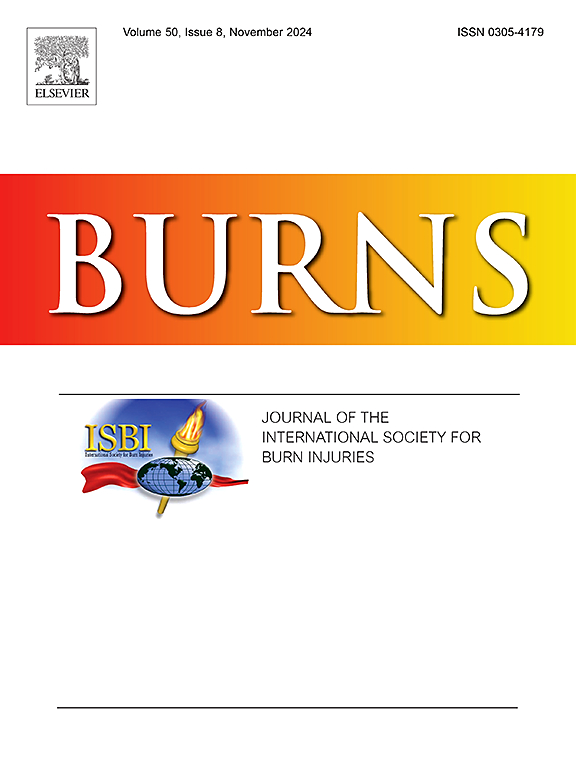冲孔切除在严重烧伤瘢痕治疗中的应用
IF 2.9
3区 医学
Q2 CRITICAL CARE MEDICINE
引用次数: 0
摘要
本研究旨在探讨严重烧伤患者广泛、过度和持久生长疤痕的穿孔切除的治疗效果。方法对2022年10月~ 2024年10月在吉林大学第一医院烧伤创面修复科治疗的烧伤增生性瘢痕患者进行回顾性比较临床观察研究。结果共纳入49例重度烧伤瘢痕患者。其中,20例接受烧蚀分数二氧化碳激光(AFCL)和冲孔切除(PE)联合治疗,29例单独接受AFCL治疗。AFCL+PE组在疤痕高度、柔韧性和感觉异常方面表现出更快、更显著的改善。治疗后1周,北卡罗来纳大学4P疤痕量表(UNC4P)柔韧性评分从2.7 ± 0.5-2.2 ± 0.6下降,感觉异常评分从2.5 ± 0.7-1.9 ± 0.9提高。温哥华疤痕量表(Vancouver Scar Scale, VSS)柔韧性评分从4.1 ± 0.8-3.4 ± 0.9下降,身高评分从3.0 ± 0.0-2.1 ± 0.6提高。指出,明显改善疤痕感觉Semmes-Weinstein单丝测试减少从32.9 ±27.2 g预处理 15.0±10.3 g(1周,进一步提高到9.5 ±7.7 g在1月和8.4 ±7.6 g(3个月。所有20例患者对AFCL+PE治疗耐受良好,无并发症。PE平均愈合时间为11.7 ± 2.2 d。术后不良反应包括色素沉着(n = 5),出现于治疗后7天,轻度瘙痒(n = 1)。结论pe是一种安全有效的疤痕处理方法,对增生性烧伤疤痕具有良好的适用性。它可以显著减少疤痕体积,迅速而广泛地改善疤痕厚度、硬度和疤痕感觉。作为一种新兴的治疗方法,与现有方法相比,穿孔切除提供了独特的治疗机制和适应症。它有可能成为当前多模式疤痕管理方法的一个组成部分。在未来,疤痕的厚度和硬度可能不再是疤痕患者主要关心的问题。本文章由计算机程序翻译,如有差异,请以英文原文为准。
Application of punch excision in the treatment of severe burn scars
Introduction
This study aims to identify the therapeutic outcomes of punch excision in severe burn patients with extensive, excessive and long-lasting growth scars.
Methods
A retrospective comparative clinical observational study was conducted on patients with burn hypertrophic scars who were treated at the Department of Burn and Skin Wound Repair, First Hospital of Jilin University, between October 2022 and October 2024.
Results
A total of 49 patients with severe burn scars were included. Of these, 20 received combined treatment with ablative fractional carbon dioxide laser (AFCL) and punch excision (PE), while 29 were treated with AFCL alone. The AFCL+PE group showed faster and more significant improvements in scar height, pliability, and paresthesias. At 1 week post-treatment, the University of North Carolina 4P Scar Scale (UNC4P) pliability score decreased from 2.7 ± 0.5–2.2 ± 0.6, and the paresthesias score improved from 2.5 ± 0.7–1.9 ± 0.9. The Vancouver Scar Scale (VSS) pliability score dropped from 4.1 ± 0.8–3.4 ± 0.9, and the height score improved from 3.0 ± 0.0–2.1 ± 0.6. Significant improvements in scar sensation were noted, with the Semmes-Weinstein monofilament test decreasing from 32.9 ± 27.2 g pre-treatment to 15.0 ± 10.3 g at 1 week, further improving to 9.5 ± 7.7 g at 1 month and 8.4 ± 7.6 g at 3 months. All 20 patients tolerated the AFCL+PE treatment well, with no complications. The average healing time for PE was 11.7 ± 2.2 days. Postoperative adverse effects included pigmentation (n = 5), which appeared 7 days post-treatment, and mild itching (n = 1).
Conclusion
PE is a safe and effective method for scar management, with excellent suitability for hypertrophic burn scars. It can achieve significant rates of scar volume reduction, rapidly and extensively improve scar thickness, hardness, and scar sensation. As an emerging treatment, punch excision offers a distinct therapeutic mechanism and indications compared to existing methods. It holds the potential to become an integral part of current multi-modal scar management approaches. In the future, scar thickness and hardness may no longer be the primary concerns for patients with scars.
求助全文
通过发布文献求助,成功后即可免费获取论文全文。
去求助
来源期刊

Burns
医学-皮肤病学
CiteScore
4.50
自引率
18.50%
发文量
304
审稿时长
72 days
期刊介绍:
Burns aims to foster the exchange of information among all engaged in preventing and treating the effects of burns. The journal focuses on clinical, scientific and social aspects of these injuries and covers the prevention of the injury, the epidemiology of such injuries and all aspects of treatment including development of new techniques and technologies and verification of existing ones. Regular features include clinical and scientific papers, state of the art reviews and descriptions of burn-care in practice.
Topics covered by Burns include: the effects of smoke on man and animals, their tissues and cells; the responses to and treatment of patients and animals with chemical injuries to the skin; the biological and clinical effects of cold injuries; surgical techniques which are, or may be relevant to the treatment of burned patients during the acute or reconstructive phase following injury; well controlled laboratory studies of the effectiveness of anti-microbial agents on infection and new materials on scarring and healing; inflammatory responses to injury, effectiveness of related agents and other compounds used to modify the physiological and cellular responses to the injury; experimental studies of burns and the outcome of burn wound healing; regenerative medicine concerning the skin.
 求助内容:
求助内容: 应助结果提醒方式:
应助结果提醒方式:


